ROMP Synthesis of Iron-Containing Organometallic Polymers †
Abstract
:1. Introduction
2. Main-chain Iron-Containing Polymers
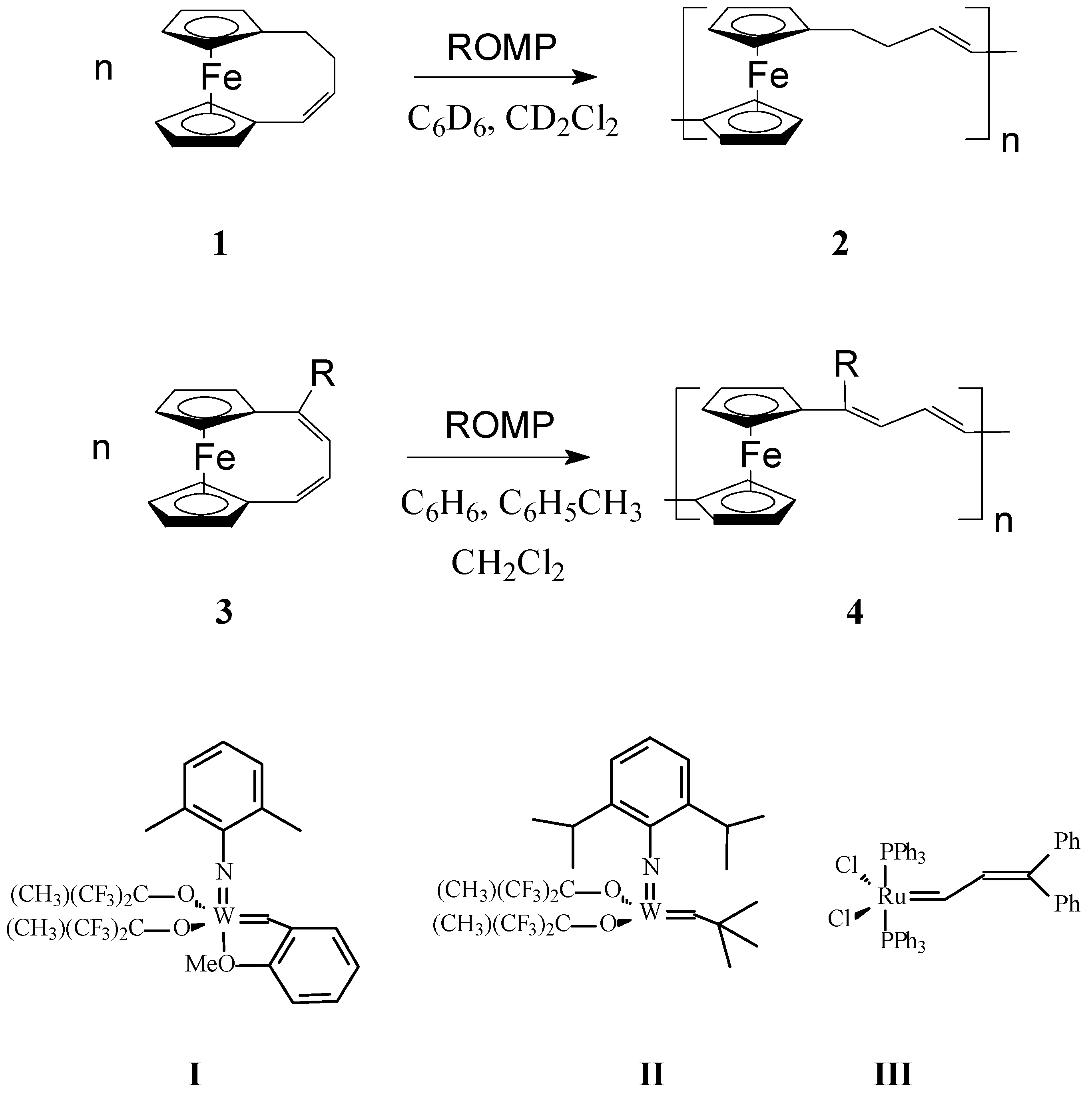
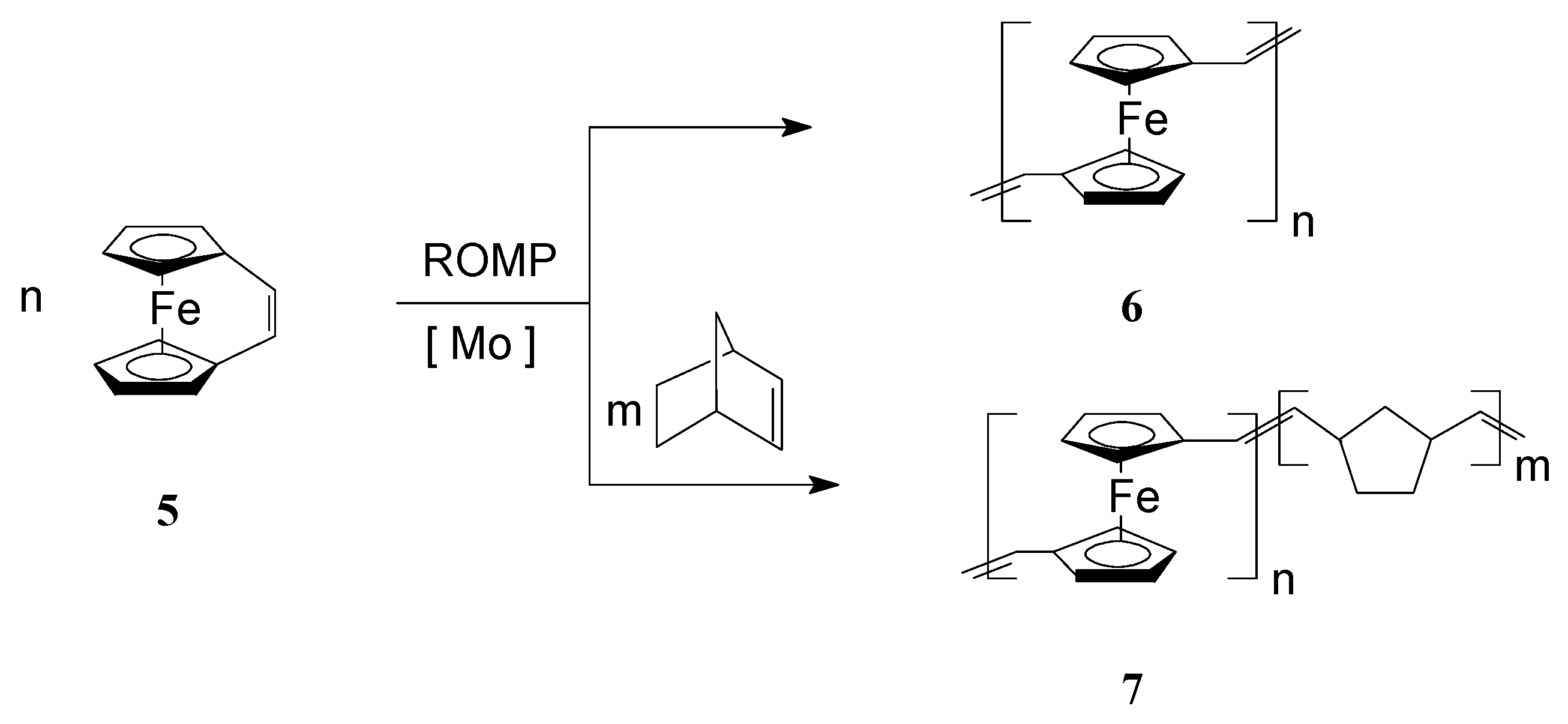
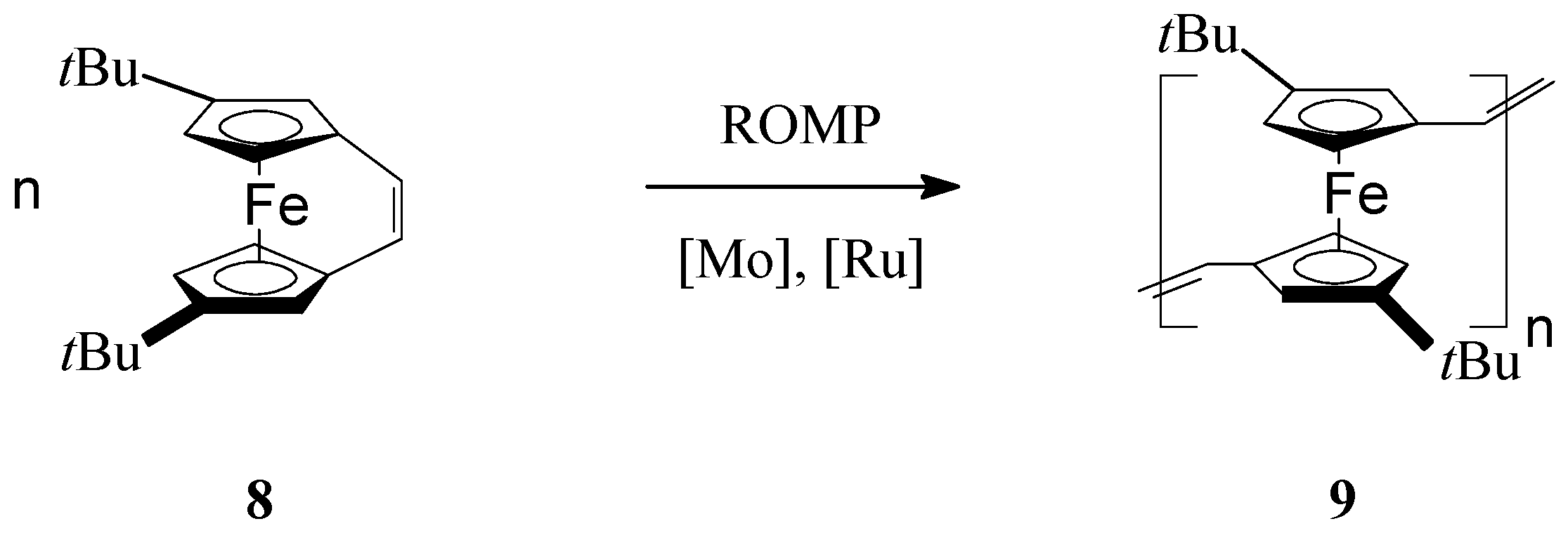
3. Inter-linked Iron-Containing Polymers
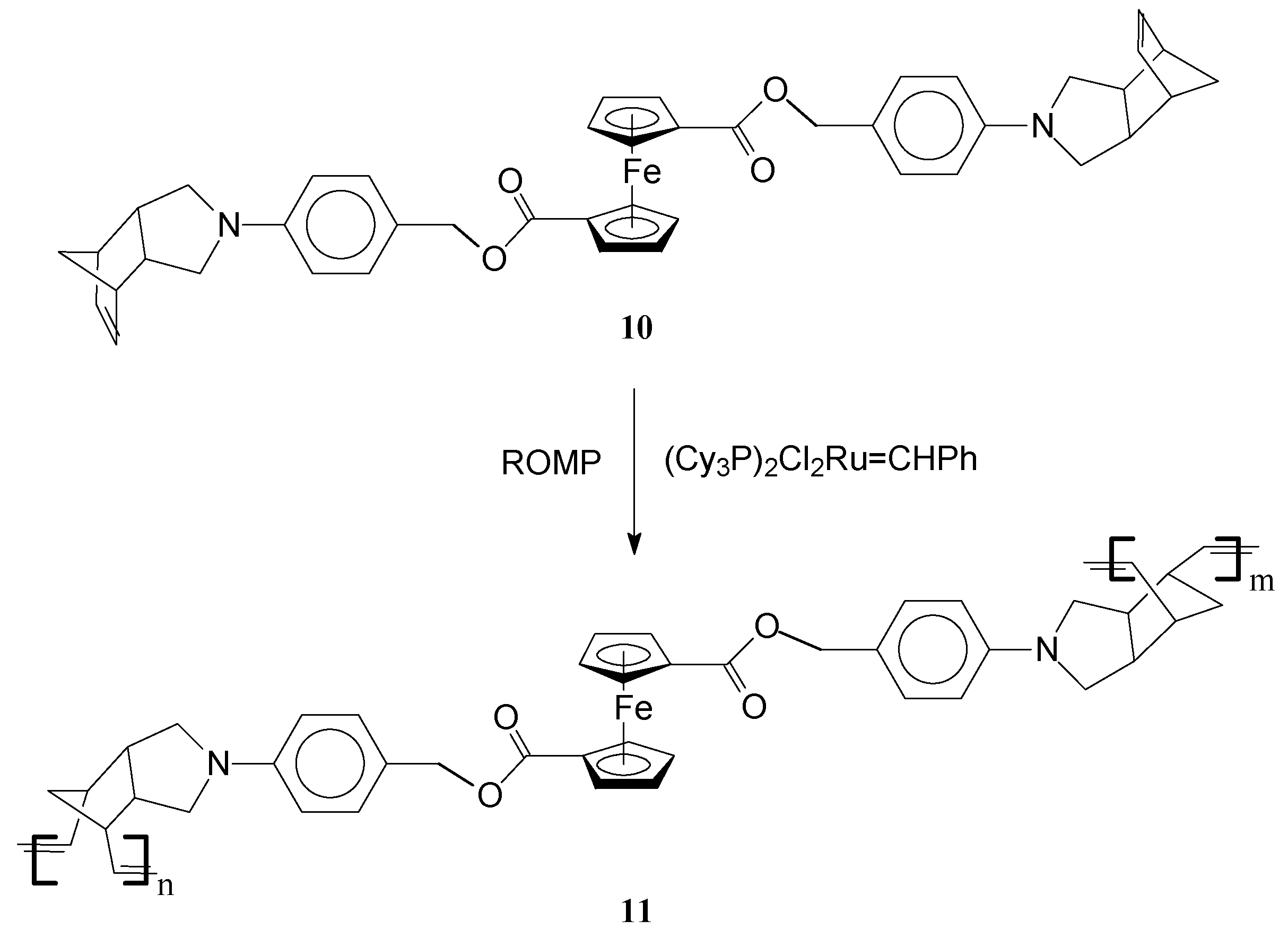
4. Side-chain Iron-Containing Polymers
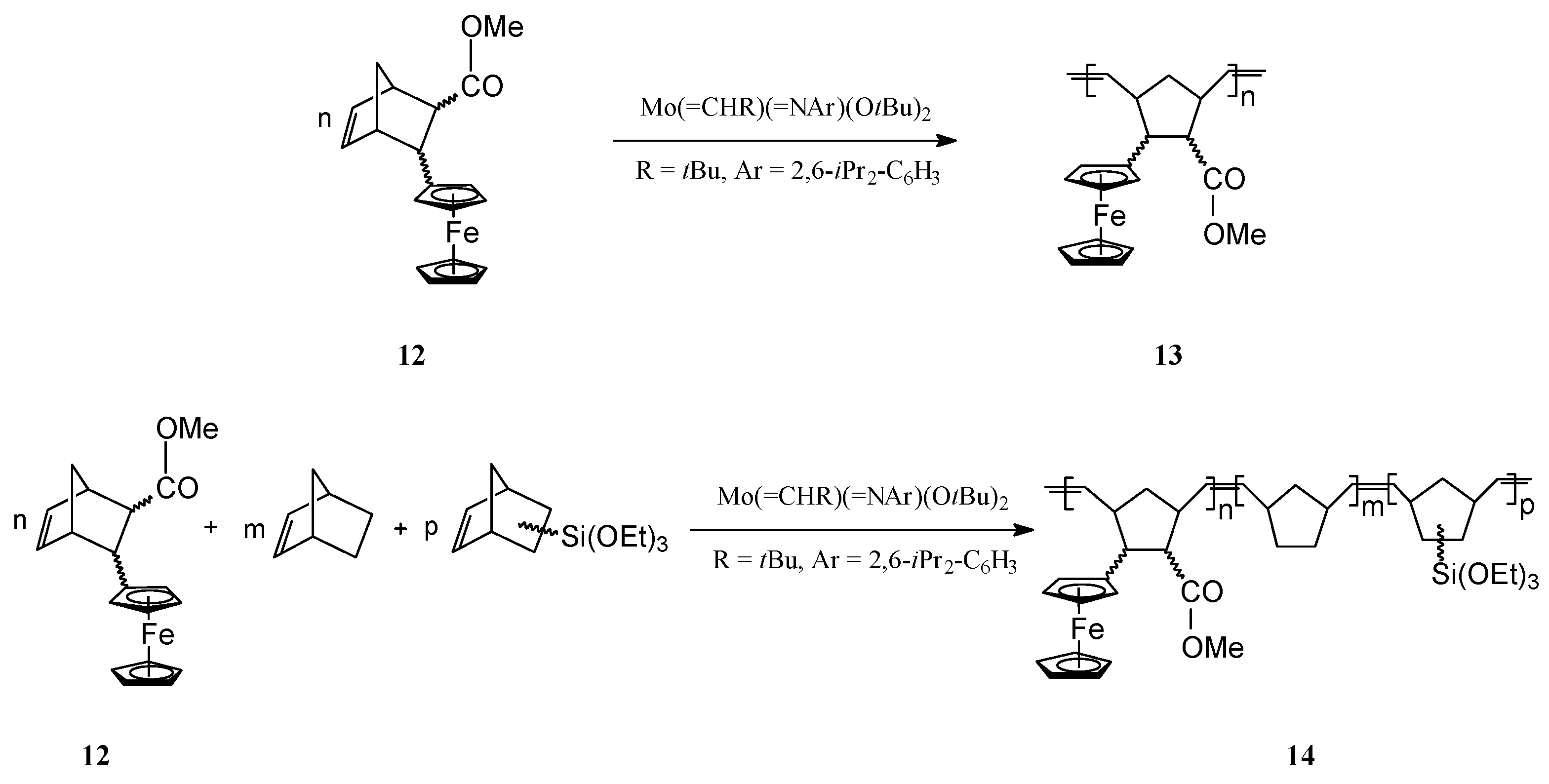
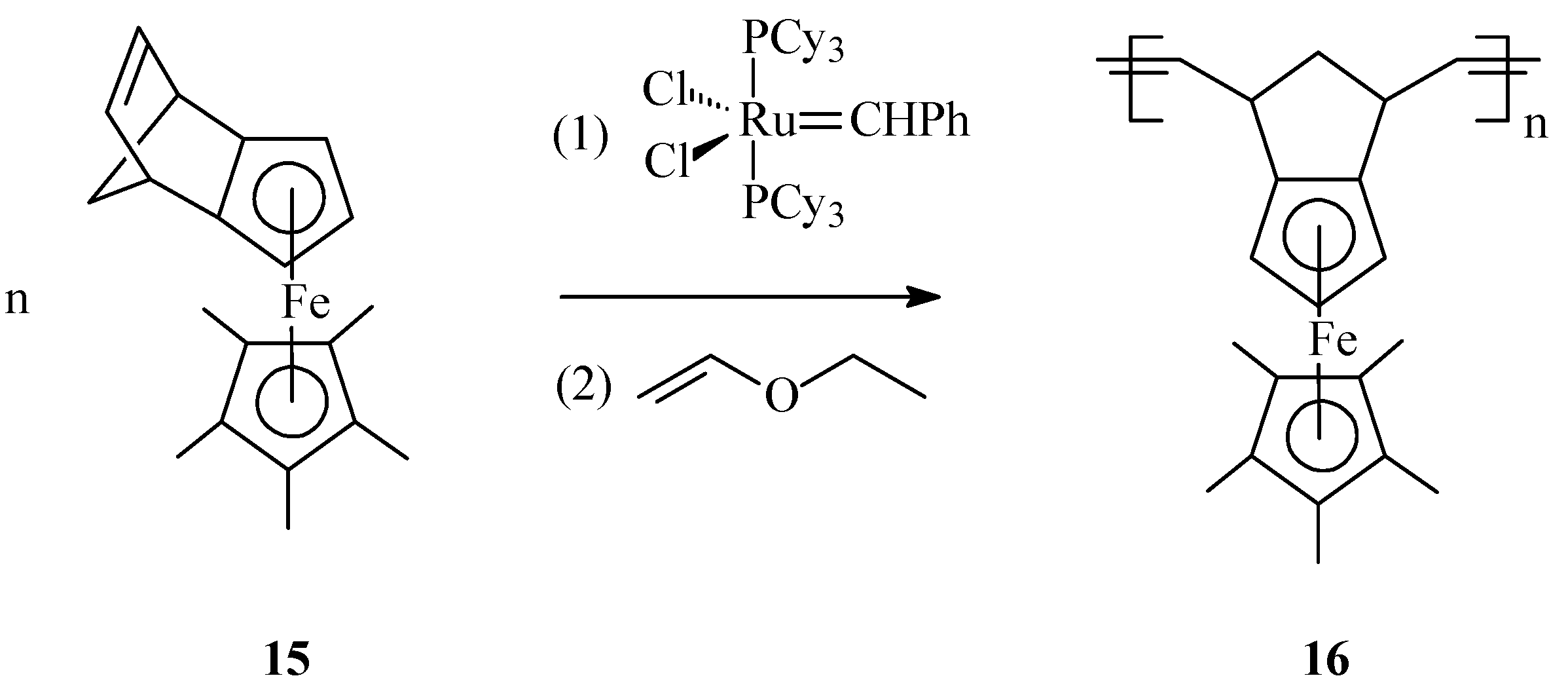
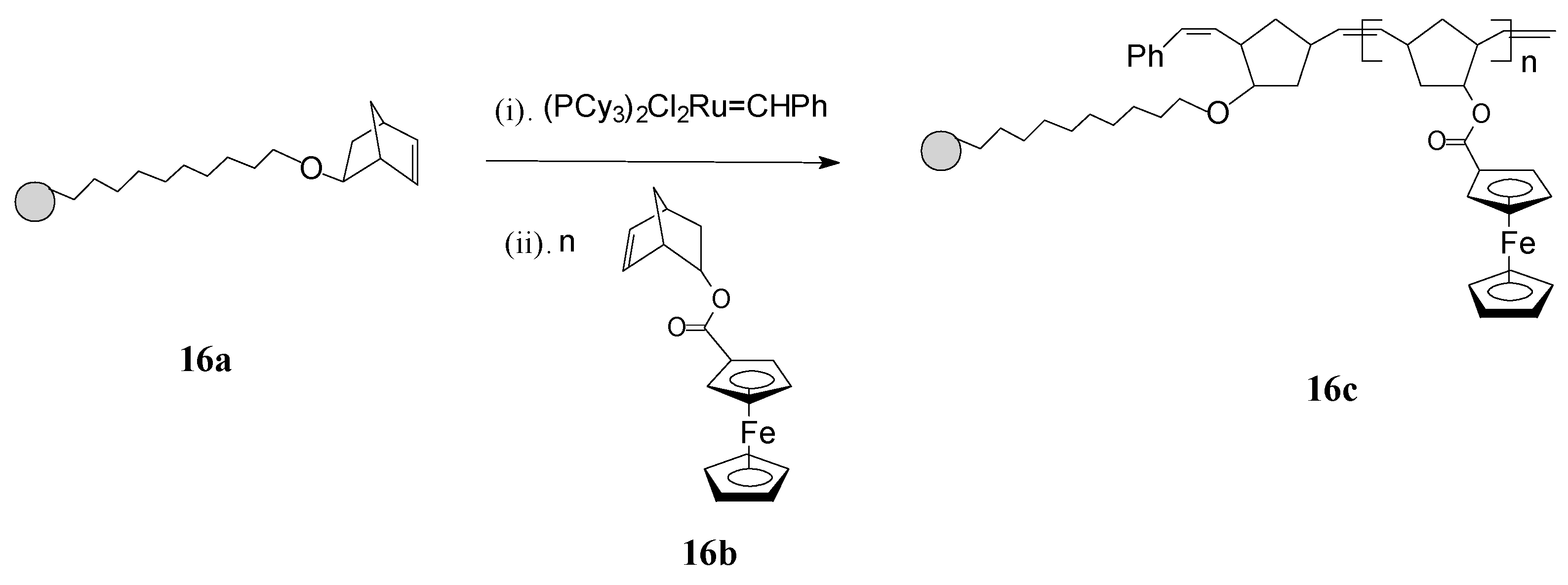
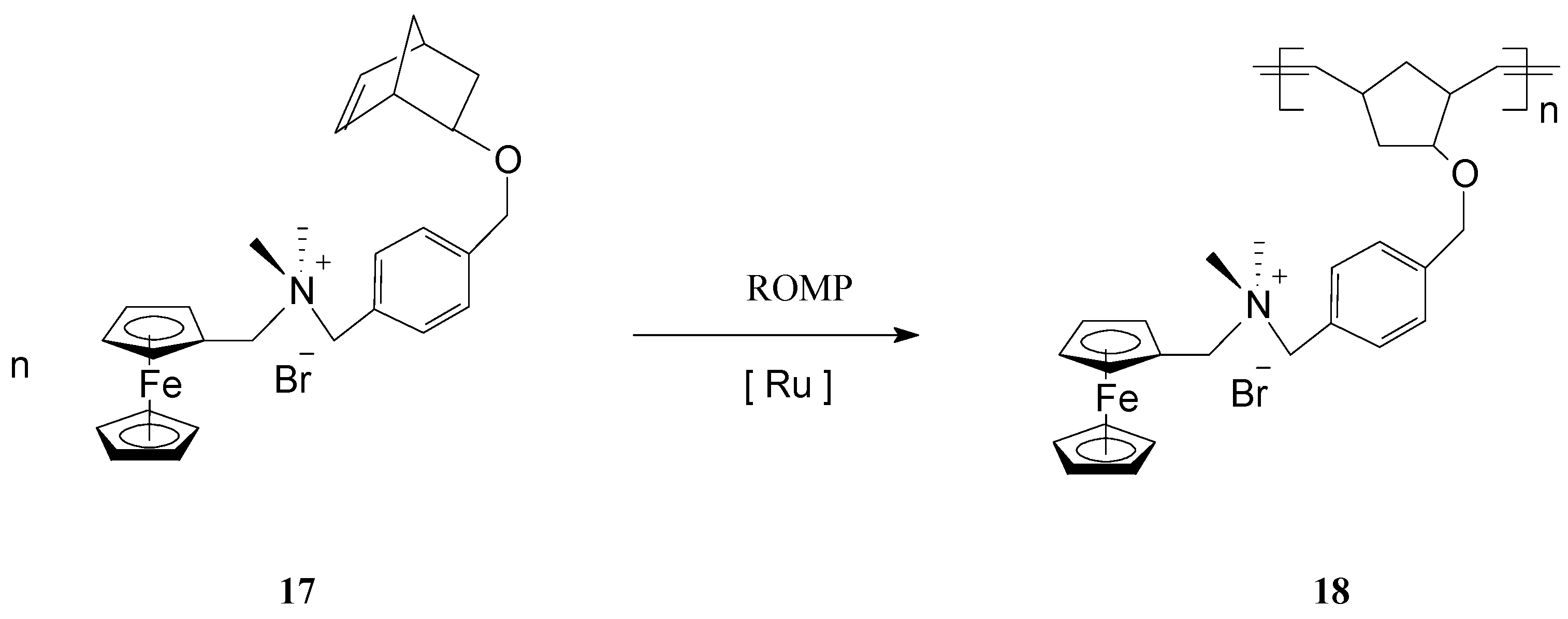

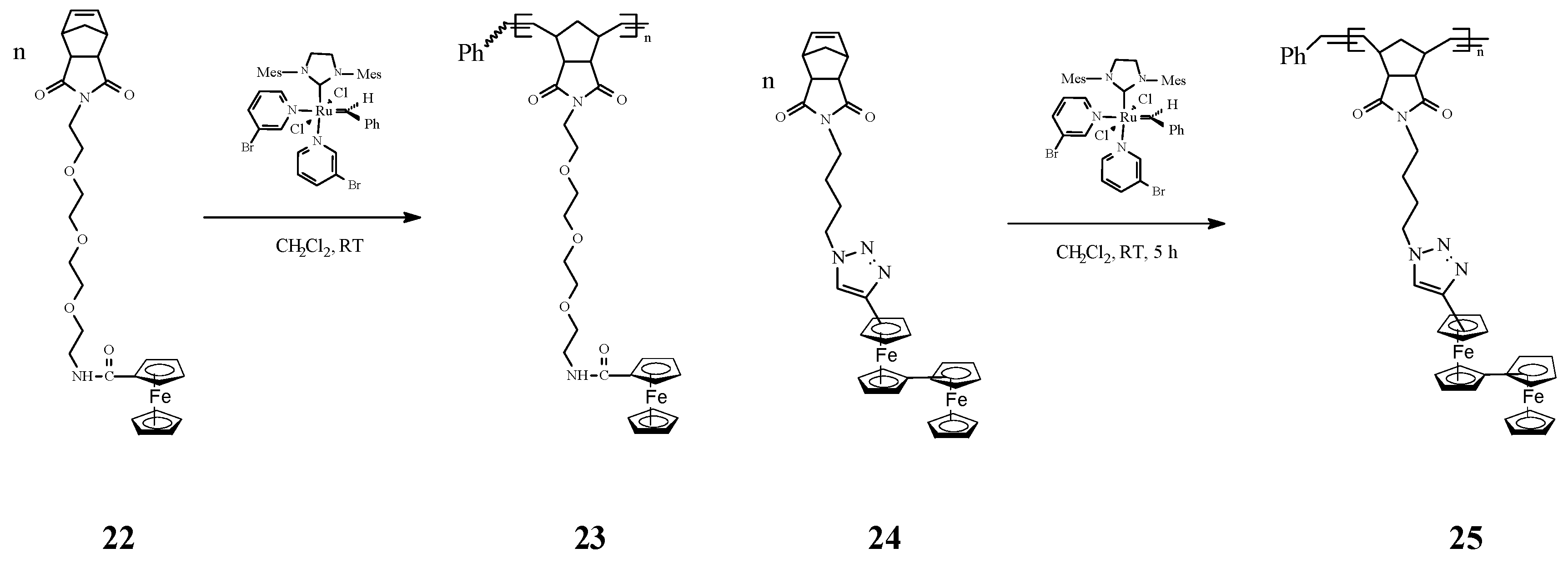

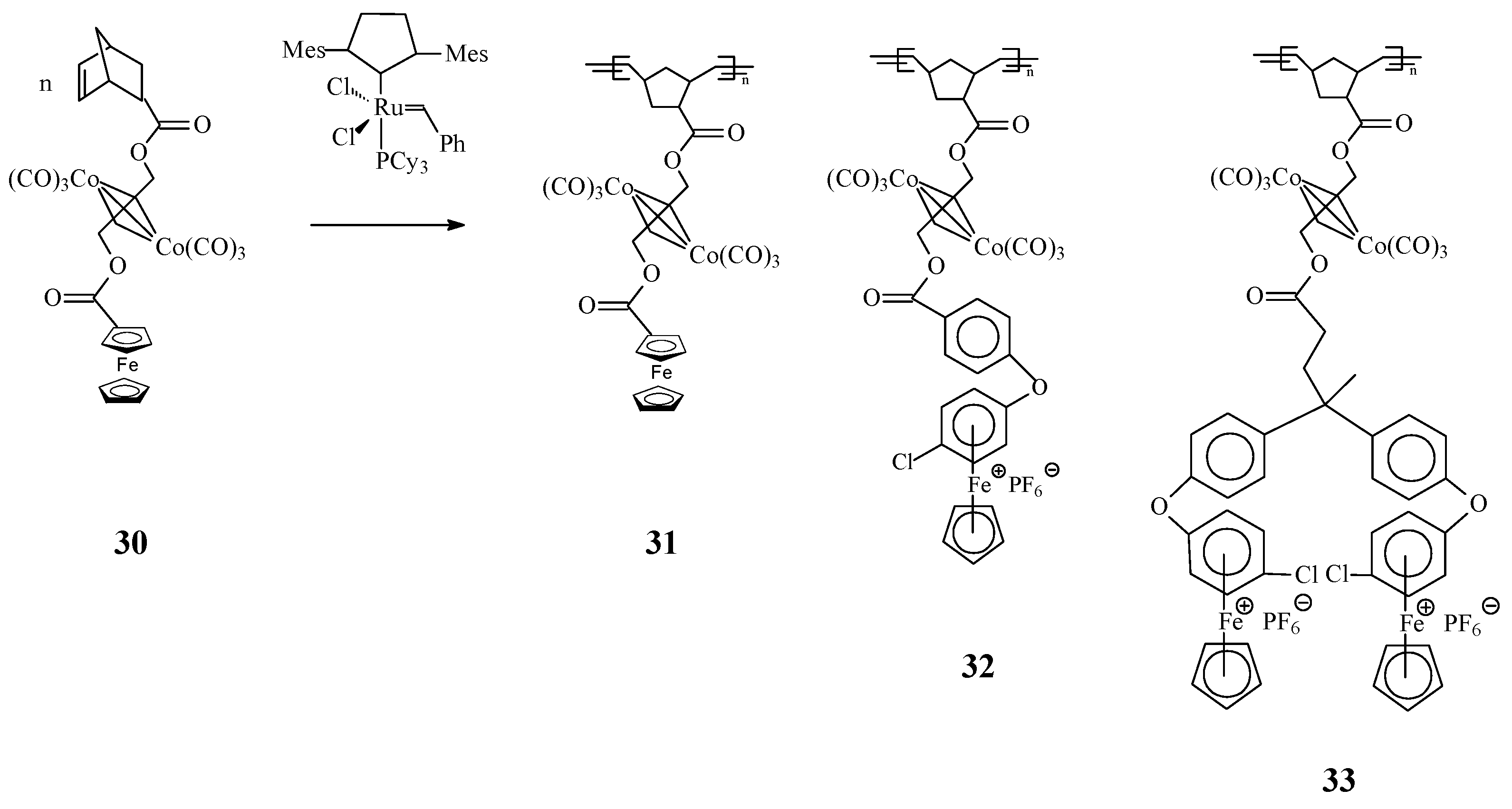
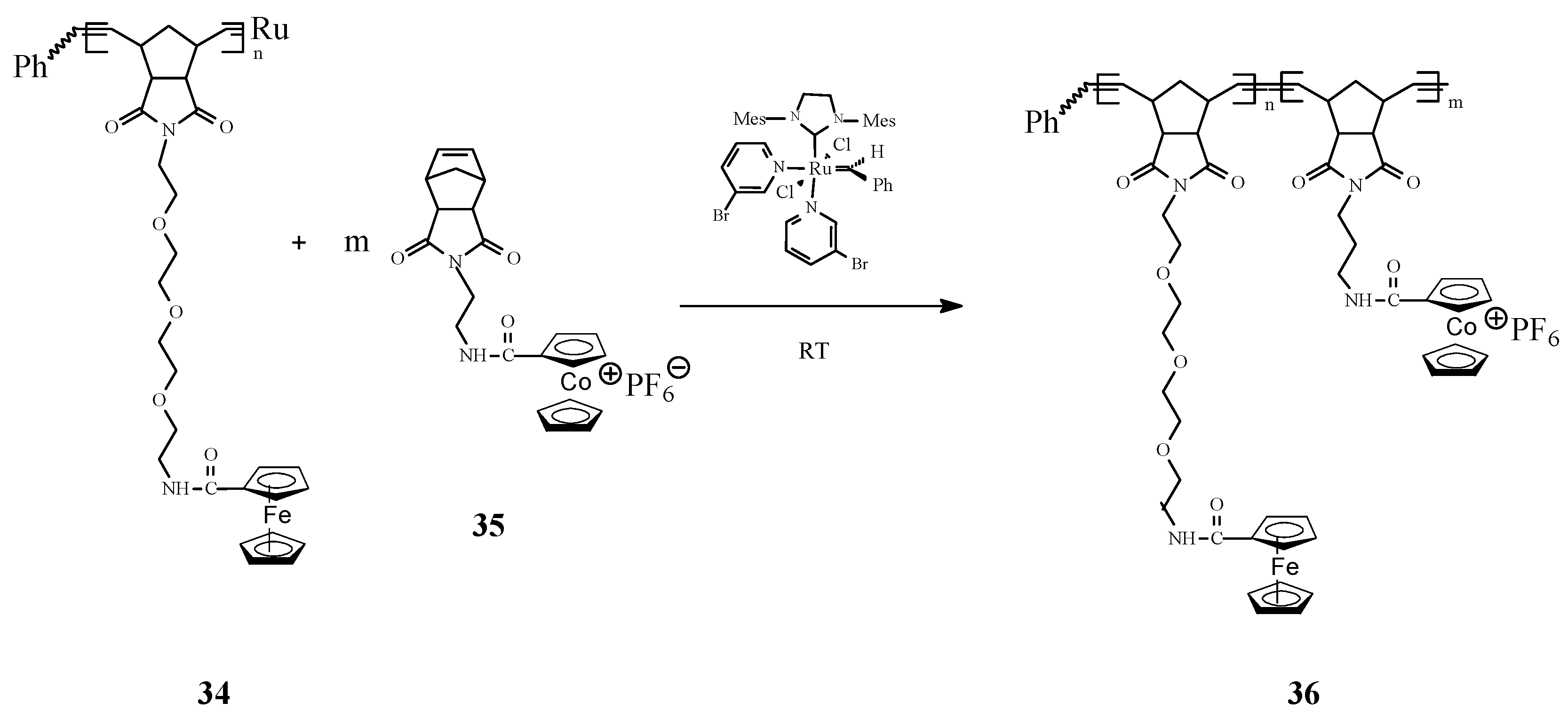
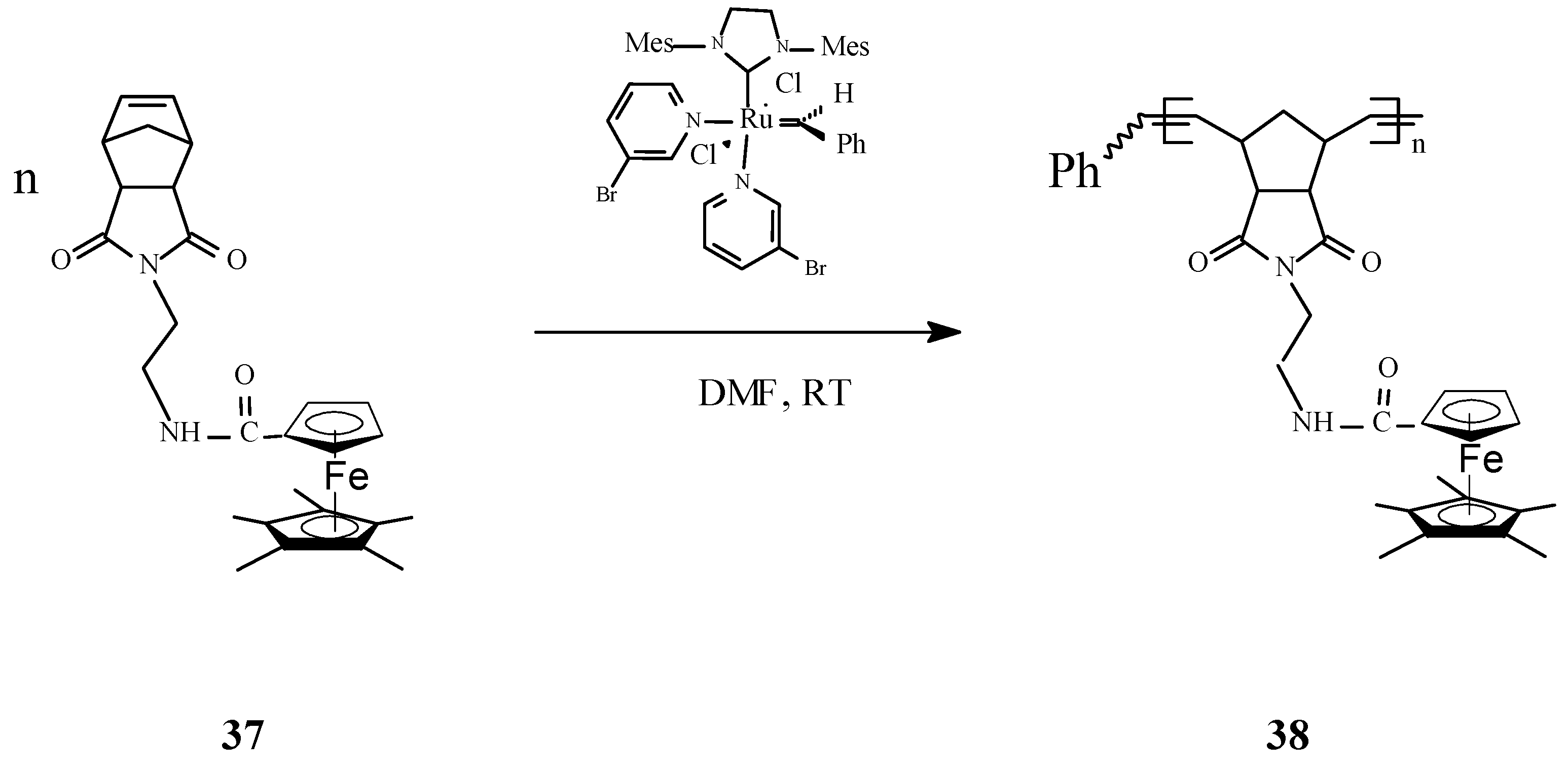
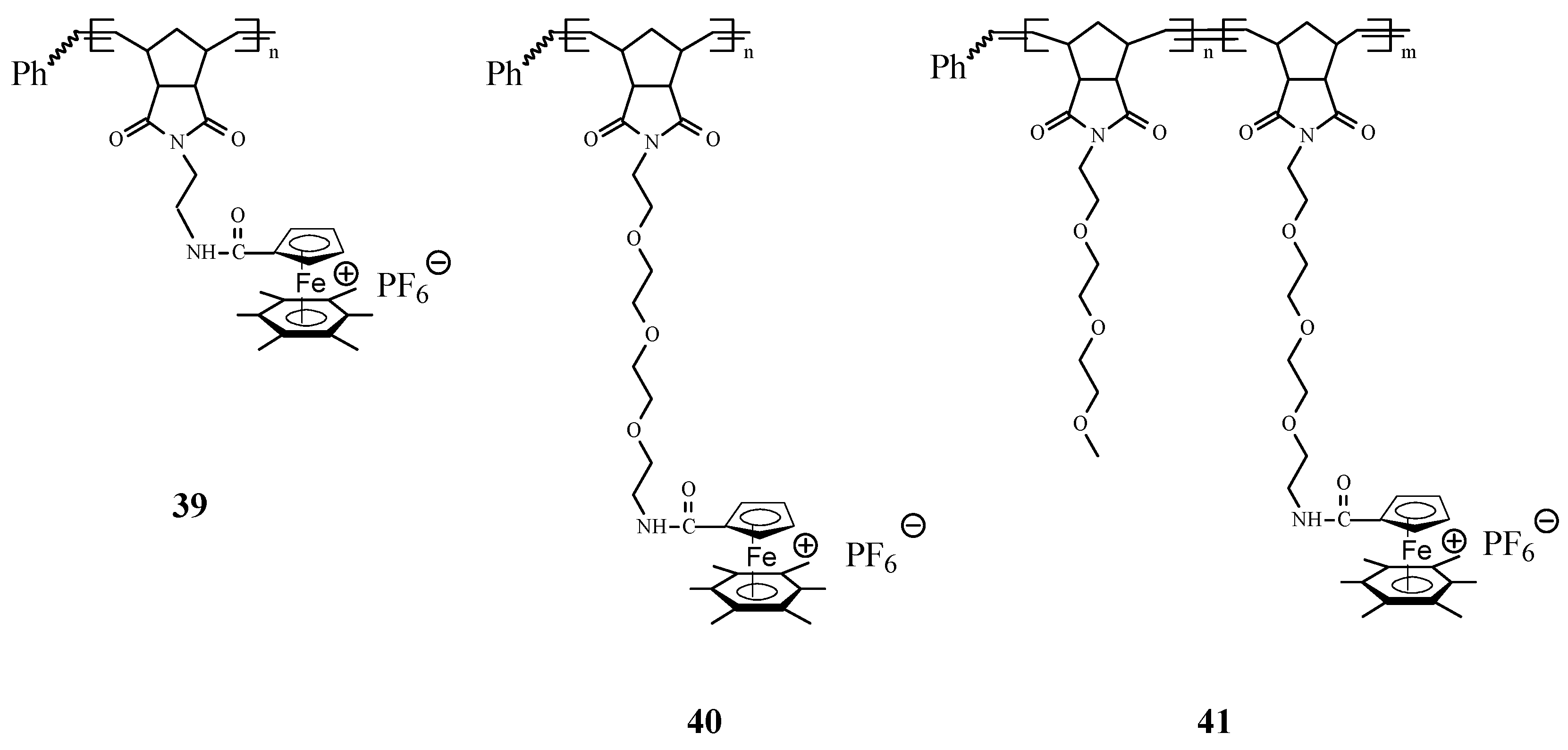
5. Branched Iron-Containing Polymers
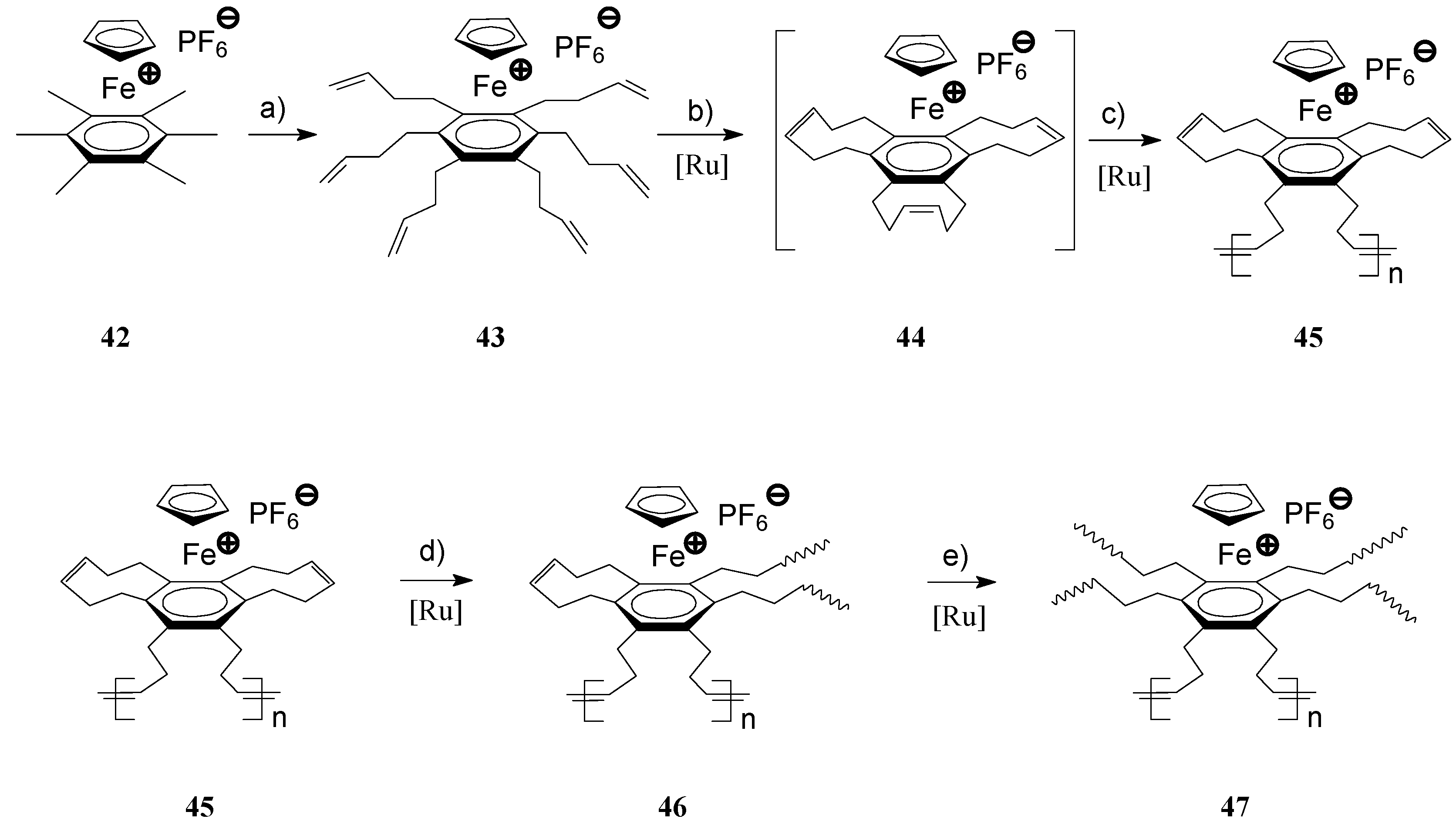
6. Conclusions
Acknowledgments
Author Contributions
Conflicts of Interest
Abbreviations
| ROMP | Ring-opening metathesis polymerization |
| Cp | Cyclopentadienyl |
| RCM | Ring-closing metathesis |
| ADMET | Acyclic diene metathesis |
| ATRP | Atom transfer radical polymerization |
| ATP | Adenosine triphosphate |
| BCP | Block-random copolymers |
| CV | Cyclic voltammetry |
| DMF | Dimethylformamide |
| GNP | Gold nanoparticle |
| GPC | Gel permeation chromatography |
| NMP | Nitroxide-mediated radical polymerization |
| PDI | Polydispersity index |
| RAFT | Reversible addition fragmentation chain transfer |
| RTF | Room temperature ferromagnetic |
| SEM | Scanning electron microscopy |
| TEM | Transmission electron microscopy |
| TrzBiFc | triazolylbiferrocenyl |
References
- Manners, I. Synthetic Metal Containing Polymers; Wiley-VCH: Weinheim, Germany, 2004. [Google Scholar]
- Zhou, J.; Whittell, G.R.; Manners, I. Metalloblock Copolymers: New Functional Nanomaterials. Macromolecules 2014, 47, 3529–3543. [Google Scholar] [CrossRef]
- Whittell, G.R.; Hager, M.D.; Schubert, U.S.; Manners, I. Functional soft materials from metallopolymers and metallosupramolecular polymers. Nat. Mater. 2011, 10, 176–188. [Google Scholar] [CrossRef] [PubMed]
- Abd-El-Aziz, A.S.; Strohm, E.A. Transition metal-containing macromolecules: En route to new functional materials. Polymer 2012, 53, 4879–4921. [Google Scholar] [CrossRef]
- Abd-El-Aziz, A.S.; Manners, I. (Eds.) Frontiers in Transition Metal Containing Polymers; John Wiley & Sons: Hoboken, NJ, USA, 2007.
- Abd-El-Aziz, A.S.; Carraher, C.E., Jr.; Pittman, C.U., Jr.; Sheats, J.; Zeldin, M. (Eds.) Macromolecules Containing Metal and Metal-Like Elements; John Wiley & Sons: Hoboken, NJ, USA, 2003; Volume 1–2, pp. 1–267/1–304.
- Ott, C; Ulbricht, C.; Hoogenboom, R.; Schubert, U.S. Metallo-Supramolecular Materials Based on Amine-Grafting onto Polypentafluorostyrene. Macromol. Rapid Commun. 2012, 33, 596–561. [Google Scholar]
- Corkum, E.G.; Hass, M.J.; Sullivan, A.D.; Bergens, S.H. A Highly Reusable Rhodium Catalyst- Organic Framework for the Intramolecular Cycloisomerization of 1,6-Enynes. Org. Lett. 2011, 13, 3522–3535. [Google Scholar] [CrossRef] [PubMed]
- Xu, J.; Bellas, V.; Jungnickel, B.; Stühn, B.; Rehahn, M. Equilibrium melting temperature of poly(ferrocenyl dimethylsilane) in homopolymers and lamellar diblock copolymers with polystyrene. Macromol. Chem. Phys. 2010, 211, 1261–1271. [Google Scholar] [CrossRef]
- Rapakousiou, A.; Djeda, R.; Grillaud, M.; Li, N.; Ruiz, J.; Astruc, D. “Click” Assemblies and Redox Properties of Arene- and Gold-Nanoparticle-Cored Triazolylbiferrocene-Terminated Dendrimers. Organometallics 2014, 33, 6953–6962. [Google Scholar] [CrossRef]
- Astruc, D.; Ciganda, R.; Deraedt, C.; Gatard, S.; Liang, L.; Li, N.; Ornelas, C.; Rapakousiou, A.; Ruiz, J.; Wang, D.; et al. Click Metallodendrimers and Their Functions. Synlett 2015, 26, 1437–1449. [Google Scholar] [CrossRef]
- Astruc, D.; Wang, Y.; Rapakousiou, A.; Diallo, A.; Djeda, R.; Ruiz, J.; Ornelas, C. Organoiron-mediated synthesis and redox activity of organoiron-containing Dendrimers. Polyhedron 2015, 86, 24–30. [Google Scholar] [CrossRef]
- Zha, Y.; Disabb-Miller, M.L.; Johnson, Z.D.; Hickner, M.A.; Tew, G.N. Metal-Cation-Based Anion Exchange Membranes. J. Am. Chem. Soc. 2012, 134, 4493–4496. [Google Scholar] [CrossRef] [PubMed]
- Mukherjee, S.; Dinda, H.; Shashank, L.; Chakraborty, I.; Bhattacharyya, R.; Das Sarma, J.; Shunmugam, R. Site-specific amphiphilic magnetic copolymer nanoaggregates for dual imaging. Macromolecules 2015, 48, 6791–6800. [Google Scholar] [CrossRef]
- Jim, C.K.W.; Qin, A.; Mahtab, F.; Lam, J.W.Y.; Tang, B.Z. Ferrocene-Functionalized disubstituted polyacetylenes with high light refractivity: Synthesis through polymer reaction by using click chemistry and application as precursors to magnetic nanoparticles. Chem. Asian J. 2011, 6, 2753–2761. [Google Scholar] [CrossRef] [PubMed]
- Schacher, F.H.; Rupar, P.A.; Manners, I. Functional Block Copolymers: Nanostructured Materials with Emerging Applications. Angew. Chem. Int. Ed. 2012, 51, 7898–7921. [Google Scholar] [CrossRef] [PubMed]
- Ho, C.-L.; Wong, W.-Y. Metal-containing polymers: facile tuning of photophysical traits and emerging applications in organic electronics and photonics. Coord. Chem. Rev. 2011, 255, 2469–2502. [Google Scholar] [CrossRef]
- AL-Badri, Z.M.; Maddikeri, R.R.; Zha, Y.; Thaker, H.D.; Dobriyal, P.; Shunmugam, R.; Russell, T.P.; Tew, G.N. Room temperature magnetic materials from nanostructured diblock copolymers. Nat. Commun. 2011, 2. [Google Scholar] [CrossRef] [PubMed]
- Dragutan, I.; Dragutan, V.; Demonceau, A. Editorial of Special Issue Ruthenium Complex: The Expanding Chemistry of the Ruthenium Complexes. Molecules 2015, 20, 17244–17274. [Google Scholar] [CrossRef] [PubMed]
- Mavila, S.; Diesendruck, C.E.; Linde, S.; Amir, L.; Shikler, R.; Lemcoff, N.G. Polycyclooctadiene Complexes of Rhodium(I): Direct Access to Organometallic Nanoparticles. Angew. Chem. Int. Ed. 2013, 52, 5767–5770. [Google Scholar] [CrossRef] [PubMed]
- Feng, W.; Zhang, Y.; Zhang, Z.; Su, P.; Lu, X.; Song, J.; Fan, D.; Wong, W.-K.; Jones, R.A.; Su, C. Near-infrared (NIR) luminescent metallopolymers based on Ln4(Salen)4 nanoclusters (Ln Ľ Nd or Yb). J. Mater. Chem. C 2014, 2, 1489–1499. [Google Scholar] [CrossRef]
- Sankaran, N.B.; Rys, A.Z.; Nassif, R.; Nayak, M.K.; Metera, K.; Chen, B.; Bazzi, H.S.; Sleiman, H.F. Ring-Opening Metathesis Polymers for Biodetection and Signal Amplification: Synthesis and Self-Assembly. Macromolecules 2010, 43, 5530–5537. [Google Scholar] [CrossRef]
- Rivard, E. Inorganic and organometallic polymers. Annu. Rep. Prog. Chem. Sect. A: Inorg. Chem. 2010, 106, 391–409. [Google Scholar] [CrossRef]
- Dragutan, V.; Dragutan, I.; Fischer, H. Synthesis of metal-containing polymers via ring opening metathesis polymerization (ROMP). Part I. Polymers containing main group metals. J. Inorg. Organomet. Polym. Mater. 2008, 18, 18–31. [Google Scholar] [CrossRef]
- Karabulut, S.; Aydogdu, C.; Düz, B.; İmamoğlu, Y. Metal-containing polymers synthesized via acyclic diene metathesis (ADMET) polymerization using electrochemically reduced tungsten-based catalyst: Polycarbosilanes. J. Inorg. Organomet. Polym.Mater. 2007, 17, 517–523. [Google Scholar] [CrossRef]
- Karabulut, S.; Aydogdu, C.; Düz, B.; İmamoğlu, Y. Metal-Containing Polymers Synthesized via Acyclic Diene Metathesis (ADMET) Polymerization Using Electrochemically Reduced Tungsten-Based Catalyst: Polycarbogermanes. J. Inorg. Organomet. Polym. Mater. 2006, 16, 115–122. [Google Scholar] [CrossRef]
- Abd-El-Aziz, A.S.; Agatemor, C.; Etkin, N. Sandwich Complex-Containing Macromolecules: Property Tunability through Versatile Synthesis. Macromol. Rapid Commun. 2014, 35, 513–559. [Google Scholar] [CrossRef] [PubMed]
- Dragutan, I.; Dragutan, V.; Fischer, H. Synthesis of metal-containing polymers via ring opening metathesis polymerization (ROMP). Part II. Polymers containing transition metals. J. Inorg. Organomet. Polym. Mater. 2008, 18, 311–324. [Google Scholar] [CrossRef]
- Cao, K.; Murshid, N.; Wang, X. Synthesis of Main-Chain Metal Carbonyl Organometallic Macromolecules (MCMCOMs). Macromol. Rapid Commun. 2015, 36, 586–596. [Google Scholar] [CrossRef] [PubMed]
- Gilroy, J.B.; Patra, S.K.; Mitchels, J.M.; Winnik, M.A.; Manners, I. Main-Chain Heterobimetallic Block Copolymers: Synthesis and Self- Assembly of Polyferrocenylsilane-b-Poly(cobaltoceniumethylene). Angew. Chem. Int. Ed. 2011, 50, 5851–5855. [Google Scholar] [CrossRef] [PubMed]
- Padhy, H.; Ramesh, M.; Patra, D.; Satapathy, R.; Pola, M.K.; Chu, H.-C.; Chu, C.-W.; Wei, K.-H.; Lin, H.-C. Synthesis of Main-Chain Metallo-Copolymers Containing Donor and Acceptor Bis-Terpyridyl Ligands for Photovoltaic Applications. Macromol. Rapid Commun. 2012, 33, 528–533. [Google Scholar] [CrossRef] [PubMed]
- Williams, K.A.; Boydston, A.J.; Bielawski, C.W. Main-chain organometallic polymers: synthetic strategies, applications, and perspectives. Chem. Soc. Rev. 2007, 36, 729–744. [Google Scholar] [PubMed]
- Dragutan, I.; Dragutan, V.; Simionescu, B.C.; Demonceau, A.; Fischer, H. Recent advances in metathesis-derived polymers containing transition metals in the side chain. Beilstein J. Org. Chem. 2015, 11, 2747–2762. [Google Scholar] [CrossRef]
- Breul, A.M.; Kübel, J.; Häupler, B.; Friebe, C.; Hager, M.D.; Winter, A.; Dietzek, B.; Schubert, U.S. Synthesis and Characterization of Poly(phenylacetylene)s with Ru(II) Bis-Terpyridine Complexes in the Side-Chain. Macromol. Rapid Commun. 2014, 35, 747–751. [Google Scholar] [CrossRef] [PubMed]
- Zhang, J.; Yan, J.; Pageni, P.; Yan, Y.; Wirth, A.; Chen, Y.-P.; Qiao, Y.; Wang, Q.; Decho, A.W.; Tang, C. Anion-Responsive Metallopolymer Hydrogels for Healthcare Applications. Sci. Rep. 2015, 5. [Google Scholar] [CrossRef] [PubMed]
- Hardy, C.G.; Ren, L.; Ma, S.; Tang, C. Self-assembly of well-defined ferrocene triblock copolymers and their template synthesis of ordered iron oxide nanoparticles. Chem. Commun. 2013, 49, 4373–4375. [Google Scholar] [CrossRef] [PubMed]
- Hardy, C.G.; Ren, L.; Zhang, J.; Tang, C. Side-Chain Metallocene-Containing Polymers by Living and Controlled Polymerizations. Isr. J. Chem. 2012, 52, 230–245. [Google Scholar] [CrossRef]
- Abd-El-Aziz, A.S.; Shipman, P.O.; Boden, B.N.; McNeil, W.S. Synthetic methodologies and properties of organometallic and coordination macromolecules. Progr. Polym. Sci. 2010, 35, 714–836. [Google Scholar] [CrossRef]
- Zeits, P.D.; Fiedler, T.; Gladysz, J.A. Ring opening metathesis polymerization of an g4-benzene complex: A direct synthesis of a polyacetylene with a regular pattern of p bound metal fragments. Chem. Commun. 2012, 48, 7925–7927. [Google Scholar] [CrossRef] [PubMed]
- Hardy, C.G.; Zhang, J.; Yan, Y.; Ren, L.; Tang, C. Metallopolymers with transition metals in the side-chain by living and controlled polymerization techniques. Progr. Polym. Sci. 2014, 39, 1742–1796. [Google Scholar] [CrossRef]
- Gao, Y.; Kogler, F.R.; Peterlik, H.; Schubert, U.S. Ring-opening metathesis polymerizations with norbornene carboxylate-substituted metal oxo clusters. J. Mater. Chem. 2006, 16, 3268–3276. [Google Scholar] [CrossRef]
- Russell, A.D.; Musgrave, R.A.; Stoll, L.K.; Choi, P.; Qiu, H.; Manners, I. Recent developments with strained metallocenophanes. J. Organomet. Chem. 2015, 784, 24–30. [Google Scholar] [CrossRef]
- Wild, A.; Winter, A.; Hager, M.D.; Görls, H.; Schubert, U.S. Perfluorophenyl-Terpyridine Ruthenium Complex as Monomer for Fast, Efficient, and Mild Metallopolymerizations. Macromol. Rapid Commun. 2012, 33, 517–521. [Google Scholar] [CrossRef] [PubMed]
- Schrock, R.R. High-Oxidation State Molybdenum and Tungsten Complexes Relevant to Olefin Metathesis. In Handbook of Metathesis Vol. 1: Catalyst Development and Mechanism, 2nd ed.; Grubbs, R.H., Wenzel, A.G., Eds.; Wiley-VCH: Weinheim, Germany, 2015; pp. 1–32. [Google Scholar]
- Vougioukalakis, G.C.; Grubbs, R.H. Ruthenium-Based Heterocyclic Carbene-Coordinated Olefin Metathesis Catalysts. Chem. Rev. 2010, 110, 1746–1787. [Google Scholar] [CrossRef] [PubMed]
- Vougioukalakis, G.C. Ruthenium-Benzylidene Olefin Metathesis Catalysts. In Olefin Metathesis: Theory and Practice; Grela, K., Ed.; John Wiley & Sons: Hoboken, NJ, USA, 2014; pp. 397–416. [Google Scholar]
- Grubbs, R.H.; Wenzel, A.G. (Eds.) Handbook of Metathesis, Volume 1: Catalyst Development and Mechanism, 2nd ed.; Wiley-VCH: Weinheim, Germany, 2015.
- Grubbs, R.H.; Wenzel, A.G.; O’Leary, D.J.; Khosravi, E. (Eds.) Handbook of Metathesis, Volume 1–3, 2nd ed.; Wiley-VCH: Weinheim, Germany, 2015.
- Schrock, R.R.; Feldman, J.; Cannizzo, L.F.; Grubbs, R.H. Ring-opening polymerization of norbornene by a living tungsten alkylidene complex. Macromolecules 1987, 20, 1169–1172. [Google Scholar] [CrossRef]
- Grubbs, R.H.; Tumas, W. Polymer synthesis and organotransition metal chemistry. Science 1989, 243, 907–915. [Google Scholar] [CrossRef] [PubMed]
- Risse, W.; Wheeler, D.R.; Cannizzo, L.F.; Grubbs, R.H. Di- and tetrafunctional initiators for the living ring-opening olefin metathesis polymerization of strained cyclic olefins. Macromolecules 1989, 22, 3205–3210. [Google Scholar] [CrossRef]
- Dragutan, V.; Demonceau, A.; Dragutan, I.; Finkelshtein, E.S. (Eds.) Green Metathesis Chemistry: Great Challenges in Synthesis, Catalysis and Nanotechnology; Springer: Dordrecht, The Netherlands, 2010.
- Cannizzo, L.F.; Grubbs, R.H. Block copolymers containing monodisperse segments produced by ring-opening metathesis of cyclic olefins. Macromolecules 1988, 21, 1961–1967. [Google Scholar] [CrossRef]
- Amer, W.A.; Wang, L.; Amin, A.M.; Ma, L.; Yu, H. Recent progress in the synthesis and applications of some ferrocene derivatives and ferrocene-based polymers. J. Inorg. Organomet. Polym. Mater. 2010, 20, 605–615. [Google Scholar] [CrossRef]
- Abd-El-Aziz, A.S.; Manners, I. Neutral and Cationic Macromolecules based on Iron Sandwich Complexes. J. Inorg. Organomet. Polym. Mater. 2005, 15, 157–195. [Google Scholar] [CrossRef]
- Stanton, E.; Lee, T.R.; Grubbs, R.H.; Lewis, N.S.; Pudelski, J.K.; Callstrom, M.; Erickson, M.S.; McLaughlin, M.L. Routes to Conjugated Polymers with Ferrocenes in Their Backbones: Synthesis and Characterization of Poly(ferrocenylenedivinylene) and Poly(ferrocenylenebutenylene). Macromolecules 1995, 28, 8713–8721. [Google Scholar] [CrossRef]
- Heo, R.W.; Park, J.-S.; Goodson, J.T.; Claudio, G.C.; Takenaga, M.; Albright, T.A.; Lee, T.R. ROMP of t-Butyl-Substituted Ferrocenophanes Affords Soluble Conjugated Polymers that Contain Ferrocene Moieties in the Backbone. Tetrahedron 2004, 60, 7225–7235. [Google Scholar] [CrossRef]
- Heo, R.W.; Somoza, F.; Lee, T.R. Soluble Conjugated Polymers that Contain Ferrocenylene Units in the Backbone. J. Am. Chem. Soc. 1998, 120, 1621–1622. [Google Scholar] [CrossRef]
- Buretea, M.A.; Don Tilley, T. Poly(ferrocenylenevinylene) from Ring-Opening Metathesis Polymerization of ansa-(Vinylene)ferrocene. Organometallics 1997, 16, 1507–1510. [Google Scholar] [CrossRef]
- Masson, G.; Lough, A.J.; Manners, I. Soluble poly(ferrocenylenevinylene) with t-butyl substituents on the cyclopentadienyl ligands via ring-opening metathesis polymerization. Macromolecules 2008, 41, 539–547. [Google Scholar] [CrossRef]
- Yang, H.-C.; Lin, S.-Y.; Yang, H.-C.; Lin, C.-L.; Tsai, L.; Huang, S.-L.; Chen, I.W.P.; Chen, C.-H.; Jin, B.-Y.; Luh, T.-Y. Molecular architecture towards helical double-stranded polymers. Angew. Chem. Int. Ed. 2006, 45, 726–730. [Google Scholar] [CrossRef] [PubMed]
- Albagli, D.; Bazan, G.; Wrighton, M.S.; Schrock, R.R. Well-defined redox-active polymers and block copolymers prepared by living ring-opening metathesis polymerization. J. Am. Chem. Soc. 1992, 114, 4150–4158. [Google Scholar] [CrossRef]
- Albagli, D.; Bazan, G.; Schrock, R.R.; Wrighton, M.S. Surface attachment of well-defined redox-active polymers and block polymers via terminal functional groups. J. Am. Chem. Soc. 1993, 115, 7328–7334. [Google Scholar] [CrossRef]
- Zhao, X.; Li, B.; Xu, S.S.; Song, H.B.; Wang, B.Q. Synthesis, structure and ring-opening metathesis polymerization of η5-pentamethylcyclopentadienyl-(η5-exo-tricyclo[5.2.1.0(2,6)]deca-2,5,8-trien-6-yl)iron. Chem. Res. Chin. Univ. 2009, 25, 662–665. [Google Scholar]
- Watson, K.J.; Zhu, J.; Nguyen, S.T.; Mirkin, C.A. Hybrid Nanoparticles with Block Copolymer Shell Structures. J. Am. Chem. Soc. 1999, 121, 462–463. [Google Scholar] [CrossRef]
- Watson, K.J.; Nguyen, S.T.; Mirkin, C.A. The synthesis and ring-opening metathesis polymerization of an amphiphilic redox-active norbornene. J. Organomet. Chem. 2000, 606, 79–83. [Google Scholar] [CrossRef]
- Abd-El-Aziz, A.S.; May, L.J.; Hurd, J.A.; Okasha, R.M. First ring-opening metathesis polymerization of norbornenes containing cationic iron moieties. J. Polym. Sci., Part A: Polym. Chem. 2001, 39, 2716–2722. [Google Scholar] [CrossRef]
- Abd-El-Aziz, A.S.; Okasha, R.M.; May, L.J.; Hurd, J.A. Synthesis of norbornenes containing cationic mono- and di(cyclopentadienyliron)arene complexes and their ring-opening metathesis polymerization. J. Polym. Sci. Part A Polym. Chem. 2006, 44, 3053–3070. [Google Scholar] [CrossRef]
- Abd-El-Aziz, A.S.; Okasha, R.M.; Afifi, T.H.; Todd, E.K. A New Class of Cationic Organoiron Polynorbornenes Containing Azo Dyes. Macromol. Chem. Phys. 2003, 204, 555–563. [Google Scholar] [CrossRef]
- Abd-El-Aziz, A.S.; Okasha, R.M.; Afifi, T.H. First Example of Benzothiazole Azo Dyes Containing Cyclopentadienyliron Polynorbornene Macromolecules. J. Inorg. Organomet. Polym. 2004, 14, 269–278. [Google Scholar] [CrossRef]
- Gu, H.; Rapakousiou, A.; Castel, P.; Guidolin, N.; Pinaud, N.; Ruiz, J.; Astruc, D. Living Ring-Opening Metathesis–Polymerization Synthesis and Redox-Sensing Properties of Norbornene Polymers and Copolymers Containing Ferrocenyl and Tetraethylene Glycol Groups. Organometallics 2014, 33, 4323–4335. [Google Scholar] [CrossRef]
- Rapakousiou, A.; Deraedt, C.; Irigoyen, J.; Wang, Y.; Pinaud, N.; Salmon, L.; Ruiz, J.; Moya, S.; Astruc, D. Synthesis and Redox Activity of “Clicked” Triazolylbiferrocenyl Polymers, Network Encapsulation of Gold and Silver Nanoparticles and Anion Sensing. Inorg. Chem. 2015, 54, 2284–2299. [Google Scholar] [CrossRef] [PubMed]
- Zha, Y.; Thaker, H.D.; Maddikeri, R.R.; Gido, S.P.; Tuominen, M.T.; Tew, G.N. Nanostructured block-random copolymers with tunable magnetic properties. J. Am. Chem. Soc. 2012, 134, 14534–14541. [Google Scholar] [CrossRef] [PubMed]
- Abd-El-Aziz, A.S.; Winram, D.J.; Shipman, P.O.; Bichler, L. Polynorbornenes Containing Ferrocene Derivatives and Alkyne-bis(tricarbonylcobalt). Macromol Rapid Commun. 2010, 31, 1992–1997. [Google Scholar] [CrossRef] [PubMed]
- Ciganda, R.; Gu, H.; Castel, P.; Zhao, P.; Ruiz, J.; Hernández, R.; Astruc, D. Living ROMP Synthesis and Redox Properties of Diblock Ferrocene/Cobalticenium Copolymers. Macromol. Rapid Commun. 2015. [Google Scholar] [CrossRef] [PubMed]
- Gu, H.; Dr. Ciganda, R.; Castel, P.; Vax, A.; Gregurec, D.; Irigoyen, J.; Moya, S.; Salmon, L.; Zhao, P.; Ruiz, J.; et al. Redox-Robust Pentamethylferrocene Polymers and Supramolecular Polymers, and Controlled Self-Assembly of Pentamethylferricenium Polymer-Embedded Ag, AgI, and Au Nanoparticles. Chem. Eur. J. 2015, 21, 18177–18186. [Google Scholar] [CrossRef] [PubMed]
- Gu, H.; Ciganda, R.; Hernandez, R.; Castel, P.; Zhao, P.; Ruiz, J.; Astruc, D. ROMP Synthesis and Redox Properties of Polycationic Metallopolymers Containing the Electron-Reservoir Complex [Fe(η5‑C5H5)(η6‑C6Me6)][PF6]. Macromolecules 2015, 48, 6071–6076. [Google Scholar] [CrossRef]
- Astruc, D.; Ornelas, C.; Ruiz, J. Ferrocenyl-terminated dendrimers: Design for applications in molecular electronics, molecular recognition and catalysis. J. Inorg. Organomet. Polym. Mater. 2008, 18, 1–4. [Google Scholar] [CrossRef]
- Diallo, A.K.; Ruiz, J.; Astruc, D. Synthesis, Redox Activity of Rigid Ferrocenyl Dendrimers, and Isolation of Robust Ferricinium and Class-II Mixed-Valence Dendrimers. Chem. Eur. J. 2013, 19, 8913–8921. [Google Scholar] [CrossRef] [PubMed]
- Astruc, D.; Ruiz, J. On the Redox Chemistry of Ferrocenes and Other Iron Sandwich Complexes and Its Applications. J. Inorg. Organomet. Polym. Mater. 2015, 25, 330–338. [Google Scholar] [CrossRef]
- Gatard, S.; Deraedt, C.; Rapakousiou, A.; Sonet, D.; Salmon, L.; Ruiz, J.; Astruc, D. New Polysilyl Dendritic Precursors of Triazolylferrocenyl and Triazolylcobalticenium Dendrimers—Comparative Electrochemical Study and Stabilization of Small, Catalytically Active Pd Nanoparticles. Organometallics 2015, 34, 1643–1650. [Google Scholar] [CrossRef]
- Martinez, V.; Blais, J.-C.; Bravic, C.; Astruc, D. Coupling Multiple Benzylic Activation of Simple Arenes by CpFe+ with Multiple Alkene Metathesis Using Grubbs Catalysts: An Efficient Carbon−Carbon Bond Formation Strategy Leading to Polycycles, Cyclophanes, Capsules, and Polymeric Compounds and Their CpFe+ Complexes. Organometallics 2004, 23, 861–874. [Google Scholar]
- Astruc, D.; Martinez, V. The Olefin Metathesis Reactions Combined with Organo-Iron Arene Activation Towards Dendrimers, and Polymers. In Metathesis Chemistry: From Nanostructure Design to Synthesis of Advanced Materials; Imamoglu, Y., Dragutan, V., Eds.; Springer: Dordrecht, The Netherlands, 2007; pp. 223–236. [Google Scholar]
© 2016 by the authors. Licensee MDPI, Basel, Switzerland. This article is an open access article distributed under the terms and conditions of the Creative Commons by Attribution (CC-BY) license ( http://creativecommons.org/licenses/by/4.0/).
Share and Cite
Dragutan, I.; Dragutan, V.; Filip, P.; Simionescu, B.C.; Demonceau, A. ROMP Synthesis of Iron-Containing Organometallic Polymers. Molecules 2016, 21, 198. https://doi.org/10.3390/molecules21020198
Dragutan I, Dragutan V, Filip P, Simionescu BC, Demonceau A. ROMP Synthesis of Iron-Containing Organometallic Polymers. Molecules. 2016; 21(2):198. https://doi.org/10.3390/molecules21020198
Chicago/Turabian StyleDragutan, Ileana, Valerian Dragutan, Petru Filip, Bogdan C. Simionescu, and Albert Demonceau. 2016. "ROMP Synthesis of Iron-Containing Organometallic Polymers" Molecules 21, no. 2: 198. https://doi.org/10.3390/molecules21020198
APA StyleDragutan, I., Dragutan, V., Filip, P., Simionescu, B. C., & Demonceau, A. (2016). ROMP Synthesis of Iron-Containing Organometallic Polymers. Molecules, 21(2), 198. https://doi.org/10.3390/molecules21020198







